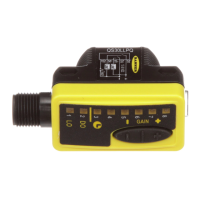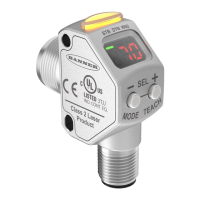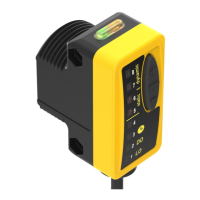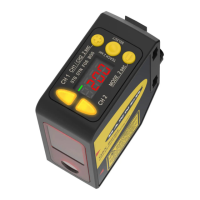© Banner Engineering Corp. www.bannerengineering.com 20
SENSOR PROGRAMMING
belt or web which influences the signal from the reference surface). For example, if the signal from the reference surface changes by 10% due
to environmental effects, high speed adaptive tracking adjusts the displayed value back to 100P (100%) over 2 to 3 seconds.
High speed adaptive tracking addresses certain applications where the reference surface is not stable, but the sensor must detect high speed
and high contrast targets reliably. With high speed adaptive tracking there is the potential for the sensor to adapt the thresholds to slow moving
or low contrast targets, leading to missed detection events. If the detection events are generating small signal changes of similar magnitude to
the background changes, detection problems are likely. Stabilize the reference surface to avoid this problem.
3.2.9. Window Size (und2)
Use this menu to manually set a window size for subsequent TEACH operations. This menu is available only if one-point window (foreground
suppression) mode is selected.
The default selection is Auto, where the foreground suppression (FGS) window size is automatically calculated.
This setting is automatically applied during any subsequent teach operation. The window size value represents a ±cm value, so the total window
size is twice this value. For example, a window set of 10 cm gives a 20 cm window centered around the taught point. The window size can also
be changed directly from Run mode after changing the setting to any value except Auto. For Channel 2, the output must be set to light operate
or dark operate.
Values: 0.1 cm to 291 cm
3.2.10. Base Measurement Rate (SPd)
Use this setting to select the base measurement rate. Excess gain will be affected by the response speed as shown. The total response speed
depends upon the base measurement rate setting and the averaging setting.
See Averaging on page 20 for more information.
Default: 3 ms
3.2.11. Averaging
Use the Averaging AUG menu to set the number of measurements that are averaged together for the analog output.
Increasing the averaging improves repeatability, but increases the total response speed. The default is 16. The filter can be set to 1, 2, 4, 8, 16,
32, 64, 128, 256, or 512. Use the table to determine the total response speed.
Table 9:Excess gain at base measurement rates
Base
Measurement
Rate (ms)
Base
Measurement
Rate in Sync
Mode (ms)
Ambient Light
Rejection
Excess Gain with a 90% White Card
at 100 mm at 500 mm at 1000 mm at 2000 mm at 3000 mm
0.5 1.0 Disabled 200 80 25 6 3
1.0 2.0 Enabled 200 80 25 6 3
2.0 4.0 Enabled 920 400 100 25 12
3.0 6.0 Enabled 1600 700 200 50 25
5.0 10.0 Enabled 3200 1400 400 100 50
Table 10:Response Speed (ms)
Base Measurement
Rate
Filter Setting
1 2 4 8 16 32 64 128 256 512
0.5 ms 0.5 1.5 3 7 13 26 50 100 200 400
1.0 ms 1 3 5 11 20 45 90 160 320 650
2.0 ms 3 5 9 20 40 80 150 300 600 1200
3.0 ms 5 8 15 30 55 110 220 420 840 1680
5.0 ms 10 15 25 45 85 170 340 680 1350 2270
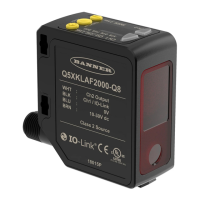
